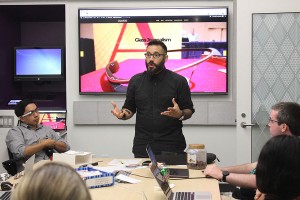Filmmaker speaks to Glass Journalism students
The Google Glass Journalism course taught through the Annenberg School for Communication and Journalism held an open meet-up Tuesday night in Wallis Annenberg Hall during which Aneesh Chaganty, a USC alumnus and director of the Google Glass short film “Seeds,” spoke via G+ Hangout.

Through the Google glass · Professor of digital journalism Robert Hernandez said the diversity of students in the course creates an engaging learning community in which to utilize Google Glass technology. – Carol Kim | Daily Trojan
Chaganty started out by sharing his perspective on Google Glass through his experience creating content using the device. “Seeds” is a short video of a man from San Francisco traveling to India to surprise his mother for Mother’s Day.
“For the first time ever, Glass allows a camera from the perspective of your eye without having something massive around your neck,” Chaganty said. “Glass allows great performances. Though people are really wary about it in the beginning, they get accustomed to it and seamlessly jump back into real life.”
After the presentation, each of the 11 students in the class pitched at least two ideas for Google Glass apps or features that could help advance the fields of journalism and media. Ideas included an app that gives the wearer contextualized information, such as relevant articles and data of wherever he or she goes, as well as an app that would allow journalists to annotate their interviews during long recording sessions.
“Chaganty mentioned how it was tricky to navigate through his content because he would get email or text notifications and his videos would be intermixed,” Vinnie Magro, a sophomore majoring in computer engineering and computer science, said. “So drawing from that, I think it would be helpful if an app could provide a better way to see what you want during content creation because you don’t want your videos to be mixed with other stuff.”
All attendees were allowed three votes to choose among the ideas pitched. From there, the class will make the final decision of what app to create throughout the course based on the feasibility of technological development and the implementation of Google Glass’ unique features. Non-USC students also attended the event to learn more about the emerging technology of Google Glass.
“My friends and I have been playing with the technology of Google Glass for about five to six months, and we were interested to see the possibilities of this application in health care,” said alumnus Prince Nnah, Marshall alumnus ’08 and chief operation officer of San Gorgonio Memorial Hospital. “Currently, physicians have to leave their present location to do research on their computers, but imagine if they could pull up the newest treatment options or recent articles instantaneously. Or if patients ask questions of things they are not aware of, to have access to information right at your fingertips would be very useful.”
Creator of the Glass Journalism class Professor Robert Hernandez hopes to continue incorporating Google Glass in the classroom, and plans to offer a course called Developing on Emerging Technologies.
“For me, the core value and goal of this class is bringing the diverse skill sets of this campus together and having these passionate and creative students not just read a textbook and talk about making something, but actually building something and engaging with the community,” Hernandez said. “People focus on Google Glass, but the part I’m most excited about is the class’ student diversity — we have a gender balance, domestic and international students, undergraduate and graduate students that are so diverse on many levels, yet the chemistry is just fantastic when they are working together.”

